Pea Puree For Babies
5
Published Feb 12, 2022, Updated Jun 12, 2023
This post may include affiliate links. Thank you for your support.
Pea puree is a great first food when introducing solids to babies and all you need is a bag of frozen peas and a blender or food processor!
Pea puree is such a great first food for babies! It has a brilliant green color and is full of nutrients, including a good amount of plant-based protein.
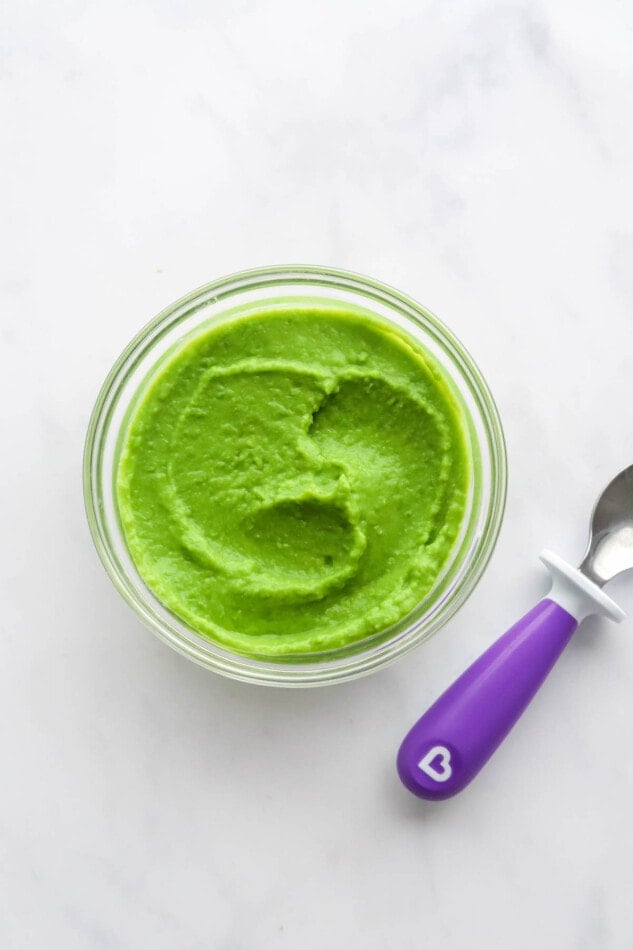
Why You’ll Love This Recipe
- Peas are naturally sweet, healthy and a great option for introducing your baby to solids!
- It’s smooth, creamy and a beautiful green color sure to entice and excite your baby.
- Peas are a great source of protein, fiber and vitamins.
Pea Nutrition for Infants
Peas are an excellent legume to feed your baby! Yep, you read correctly… despite what most people think, peas are actually a legume and not a vegetable. They fall into the same category as lentils, chickpeas and even peanuts! However, most often peas are categorized as a starchy vegetable, similar to corn and potatoes.
When starting your baby on solids, peas are a great first choice. They’re naturally sweet and pack a punch with nutrition, containing a variety of vitamins, minerals and antioxidants.
Peas also have a higher protein content at 4 grams per half cup serving. Plus, you’ll find vitamins A, K and C, thiamine, folate, manganese, iron and phosphorus in peas! (source) These are all crucial in helping baby grow and develop. And fiber is great for their little digestive systems.
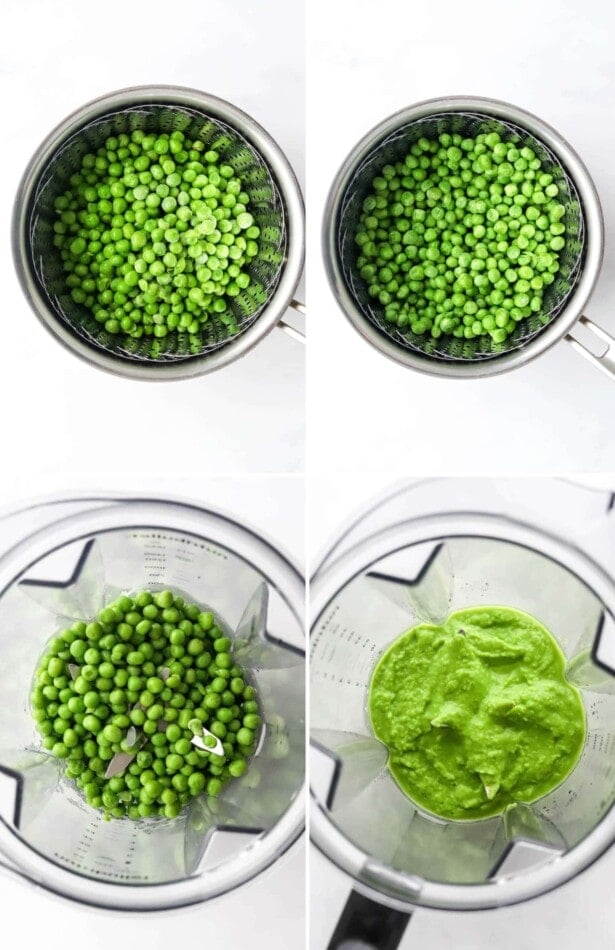
How to Make a Puree
Making pea puree is super simple! I like using frozen peas, but fresh peas work as well. Either way, you’ll want to steam them first.
To steam the peas, fill a pot with about 1 inch of water and add a steamer basket to the pot. Then add 2 cups of peas. Bring the water to a low boil, cover with a lid and steam the peas for about 3-6 minutes. You’ll know the peas are done when they are bright green and tender. Remove from heat and let peas cool.
Once cooled, place the peas in a high powered blender or food processor and blend into a puree. You can add breast milk, formula or water as needed to get the desired consistency.
tip! After steaming, give the peas a cold water bath to preserve that brilliant green color and stop them from cooking!
Baby Food Combinations with Peas
For early stage 1 eaters, pea puree served plain with a spoon is perfect. You want to make sure it’s very thin with no lumps, so thin it out with water, formula or breast milk if necessary. When baby starts moving into stage 2 and 3 foods you can make fun combination purees (see ideas below) or add pea puree to different foods like yogurt, smoothies and oatmeal for babies.
Foods That Pair Well With Pea Puree
- Green veggies – kale, spinach, avocado, zucchini
- Orange veggies – sweet potato, butternut squash, carrot
- White veggies – cauliflower
- Other fruit – banana, strawberries, peaches, apples, kiwis, pears, mangos
- Dairy – yogurt, cottage cheese, ricotta cheese
- Grains – quinoa, oats
- Legumes – chickpeas, lentils
- Seasonings and spices – curry, ginger, mint, nutmeg, cinnamon
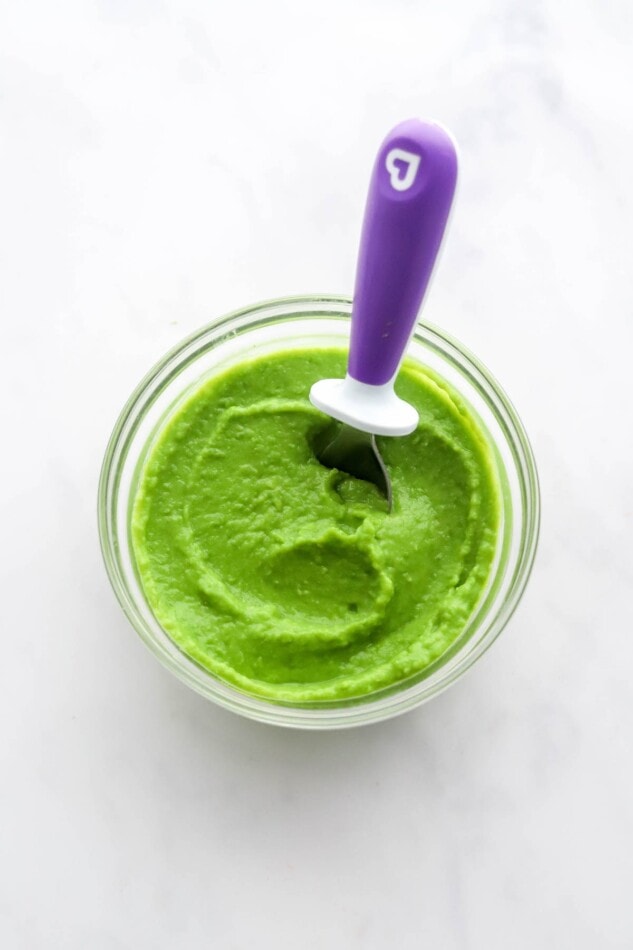
Pea Baby Food Combo Ideas
Peas and carrots are probably the most common baby food combination you’ll find in stores, but there are a ton a different baby food combinations with peas.
- Carrots and peas
- Peas and mint
- Zucchini, peas and lentils
- Pear and peas
- Mango, pear and peas
- Apple, spinach and peas
- Yogurt, peas and apples
- Carrot, peas and quinoa
- Banana and peas
- Peas, green beans and asparagus
Feel free to get creative, the options are really limitless! For more stage 2+ ideas, check out these 6 baby food combinations.
Pea Puree FAQ
The best way to keep pea puree bright green is to not overcook them. When you remove them from heat, they will keep cooking as they cool. To avoid this, give the peas an ice water bath after steaming to stop the cooking process!
If you added too much water, formula or breast milk to the puree, the best thing to do is make more pea puree to add to it. Steam and blend more peas, adding just enough water for them to blend and not stick to the blender. Then add the new puree to your watery puree to thicken. I suggest adding liquid 1 teaspoon at a time to avoid it becoming too watery.
Of course! Pea puree keeps in the fridge for 3-4 days and freezes nicely as well. I recommend freezing in small cubes so you can thaw only what you need at a time.
As long as it’s thin enough with no lumps, pea puree should be fine without straining. However, if you’re concerned or want an extra smooth puree, you can put the pea puree through a sieve or cheese cloth to reduce the fibers.
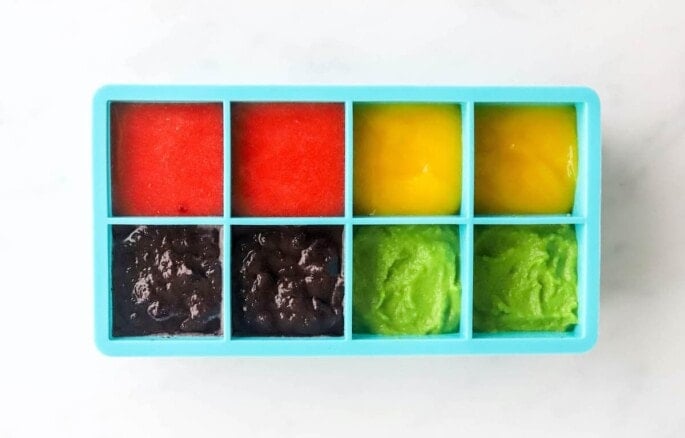
How to Store
Storing pea puree is a breeze! You can either store in the fridge for 3-4 days or in the freezer for up to 3 months. If you want to freeze, I recommended using silicone ice cube trays or small freezer-safe jars so you can easily thaw small amounts when you want to use them!
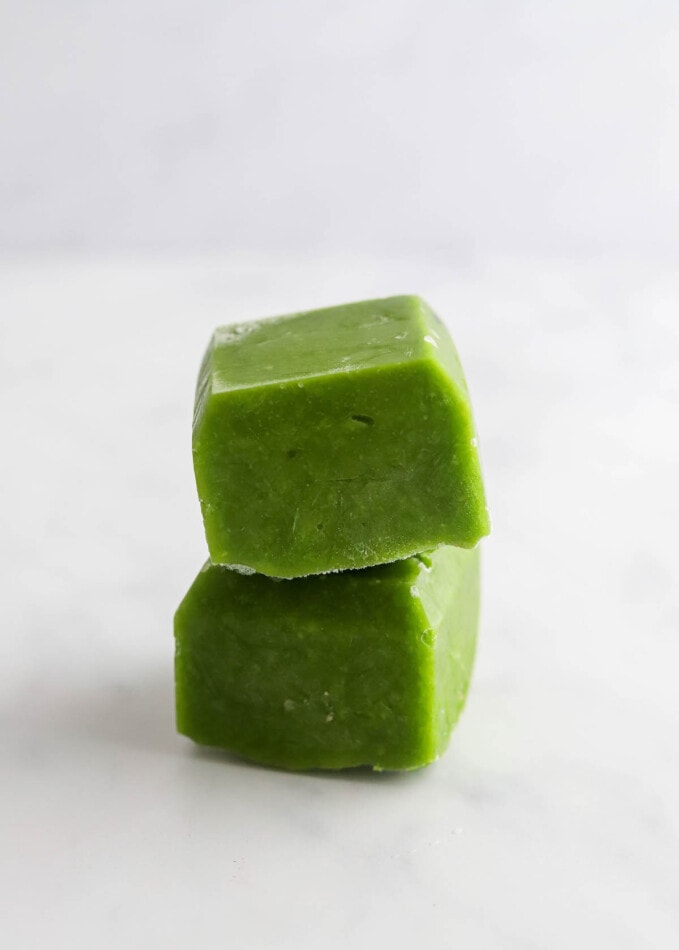
How to Reheat or Thaw Frozen Pea Puree
I recommend thawing frozen puree in the fridge the night before you want to use it, but you can also thaw it quickly with a warm water bath. It thaws quickly if you’re defrosting a small amount to serve to a baby.
Other Ways to Use Pea Puree
Pea puree is great for babies, but there are so many other ways for older kids and adults to enjoy it too. Here are some ideas:
- As a dip or spread – chefs often add ingredients like garlic, mint, butter, chicken broth and/or lemon juice to pea puree for extra flavor and use the puree to decorate a plate and add an extra layer of flavor to a dish. I could see a pea puree of this nature being great as a dip or side dish as well. This minted pea puree looks lovely.
- Make a smoothie – peas can add a boost of protein, sweetness and creamy texture to smoothies. You can add the puree straight into a smoothie, but frozen pea puree give smoothies a great texture No need to thaw, just pop a couple cubes of pea puree into your blender with the rest of your smoothie ingredients. Try it in my green protein smoothie.
More Baby Food Purees
- Sweet Potato Puree
- Butternut Squash Puree
- Peach Puree
- Carrot Puree
- Banana Puree
- Mango Puree
- Pumpkin Puree
- Applesauce
- Strawberry Puree
- Blueberry Puree
More Recipes and Resources
Check out my guide to introducing solids for more ideas and information on feeding little ones and all of my baby food recipes as well.
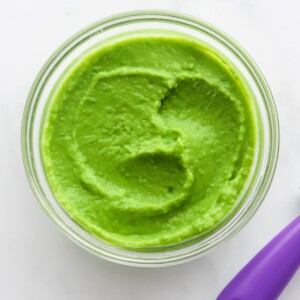
How to Make Pea Puree
Ingredients
- 2 cups frozen peas
- ⅓-½ cup water, breastmilk or formula, to thin
Instructions
- Fill a pot with about 1 inch of water, add peas to a steamer basket and place inside of the pot. Bring water to a low boil, cover with lid and steam peas for 3-6 minutes, or until bright green and tender. Remove from heat and let peas cool.
- Place peas in a blender or food processor and blend, adding liquid (breast milk, formula or water) as needed to get the desired consistency.
- Store pea puree in the fridge for 3-4 days or in the freezer or up to 3 months. I like to freeze the puree in silicone ice cube trays or small freezer-safe jars so I can easily thaw small amounts when I want to use them.
- I recommend thawing frozen puree in the fridge the night before you want to use it, but you can also thaw it quickly with a warm water bath.
Notes
- If you want to add the most nutrition to the puree, I recommend using breastmilk or formula instead of water to thin the pea puree.
Nutrition
Nutrition information is automatically calculated, so should only be used as an approximation.
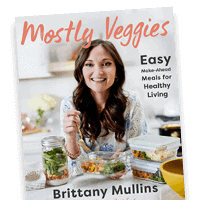
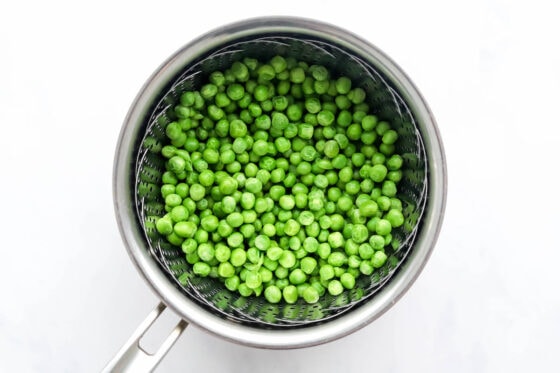
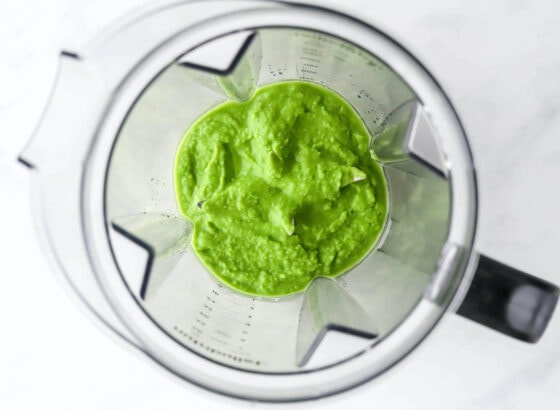
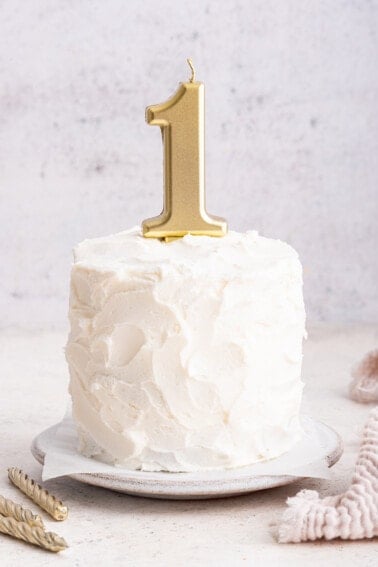
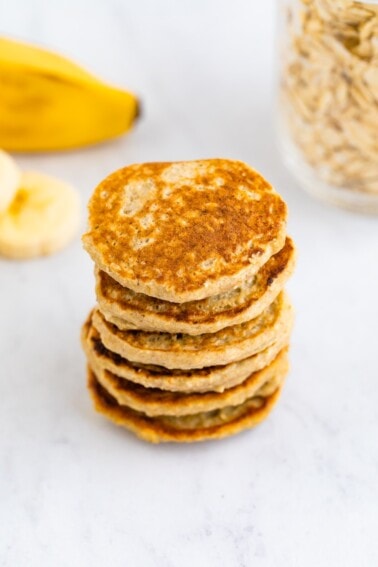
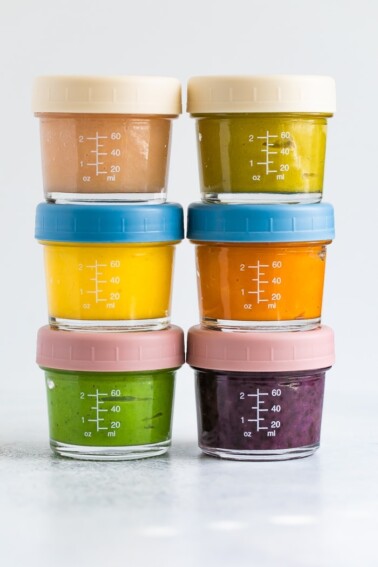
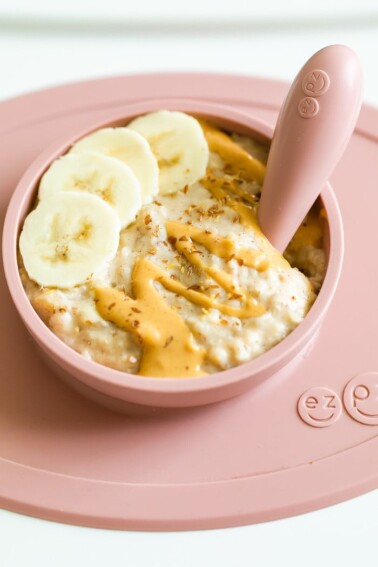
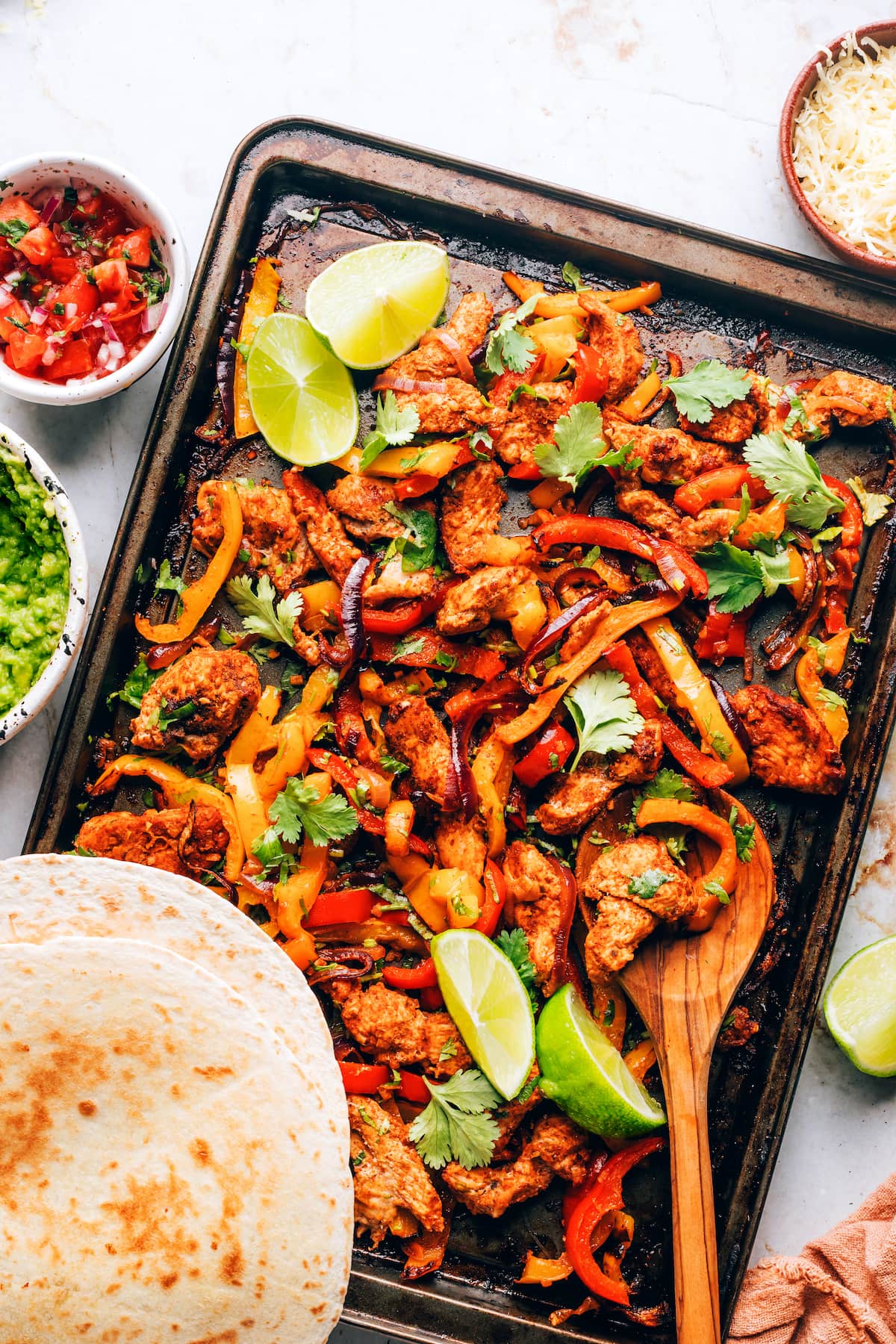






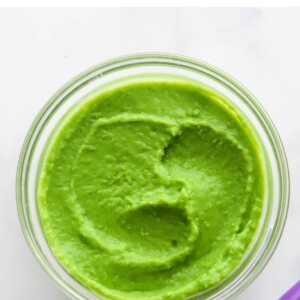
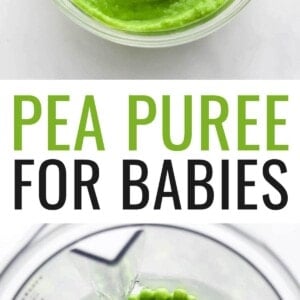
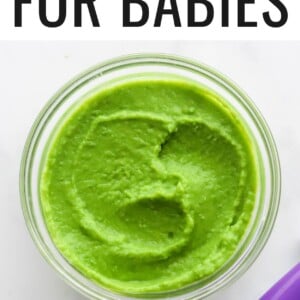
So happy to have found your puree recipes! Wondering if you could cook the peas in the microwave if you don’t have a steamer? Thank you!
Yay! I hope you enjoy them. Yes, a microwave should work, just make sure not to over/under steam them in the microwave. They might be a little tougher to monitor that way. Enjoy!
Made this for my 6 month for the first time and she loved it!
WOO! I am so happy to hear that your little one is enjoying this recipe Paige. Thank you for your review & star rating, I really appreciate it!
excellent post thank you for sharing